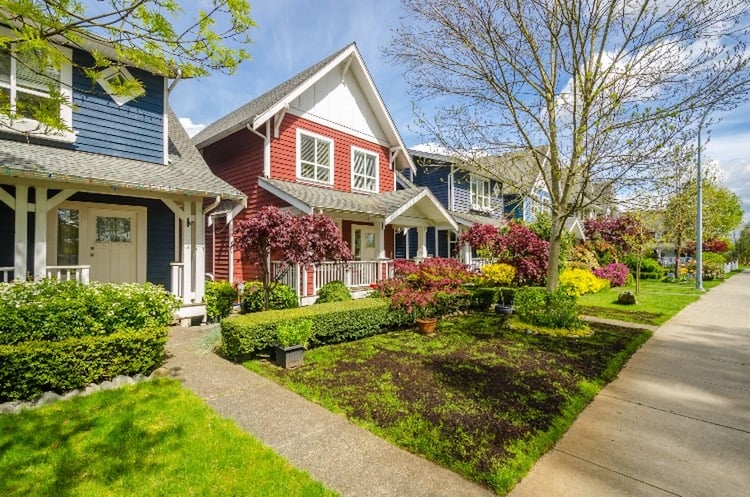By almost all measures the single-family rental market appears to be booming.
A growing number of younger people and families are renting instead of owning, helping to drive both prices and rents on single-family homes higher.
The growth in the single-family rental market is attracting capital from individual buyers, home builders, and large institutional investors seeking to profit from potential returns by investing in single-family rental homes.
Key Takeaways
- Currently, single-family homes rank #1 in both investment and development prospects.
- Over the past five years single-family home prices have increased by 50%, with values projected to grow by more than 14% over the next year.
- Rents for single-family homes are soaring, with recent rent price increases exceeding 16-year highs.
- Occupancy rates of single-family rentals are averaging 95%.
- Single-family rental homes are quickly becoming the starter homes of previous generations.
1. Single-family rentals preferred by 43% of Generation Z
The single-family rental (SFR) market shows no signs of slowing down this year. According to the Q3 2021 Single-Family Rental Investment Trends Report from Arbor Realty Trust, short-term economic factors combined with long-term demographics are two factors driving the demand for professionally managed single-family rental homes.
While younger renters once preferred to live in dense urban areas, today’s Gen-Zers (people born between 1997 and 2015) have a higher preference for vibrant suburban living than the Millennials that came before them. In fact, 43% of Gen Zers want to rent a single-family home after they graduate from university, as an earlier report from Arbor noted.
Until a real estate asset class suffers through a recession, it can be difficult to accurately predict how a real estate product type will perform during a downturn. The theory pre-pandemic was that single-family rentals would be recession-resistant, and the previous year confirmed exactly that.
2. Single-family rentals ranked #1 for best residential property prospects
The 2022 Emerging Trends in Real Estate report is a publication from the Urban Land Institute (ULI) and the multinational professional services network PricewaterhouseCoopers (PwC).
ULI surveyed over 2,000 private property owners, real estate developers, private equity investors, and advisors for the more recent report. Their research revealed that single-family homes have the best prospects for investment and new development this year.
For both investment and development, single-family homes received near-excellent ranking prospects.

3. Single-family home values projected to grow 14.3%
350%, according to data published by the Federal Reserve Bank of St. Louis. Back in 1990, houses sold for a median price of $117,000. Today, the median price of home sold in the U.S. is $404,700 (as of Q3 2021).
Zillow takes a more nuanced look at United States Home Values with the firm’s Home Value Index. According to Zillow, median home prices don’t always accurately reflect how the market is moving. Values are adjusted for factors such as historical appreciation for housing stock that existed at that time, the price level of current housing stock, and home appreciation that is driven by home improvements.
However, even though Zillow uses a different methodology to value housing, prices of single-family homes in the U.S. are fairly close to those reported by the Fed.
According to Zillow Home Value Trends, the typical value of a middle price tier single-family home is $366,000 (as of November 2021). Over the past five years, single-family home values have increased by 50%. Over the next year, Zillow projects overall home values will grow by another 14.3%.
4. Cap rates for single-family homes near record lows of 5.5%
According to the Arbor Realty Trust report mentioned above:
- SFR cap rates have declined by 0.77% over the past twelve months
- Single-family home cap rates currently average 5.5%, nearing an all-time low
- Private and institutional capital continues to flow into the SFR asset class, driving cap rates lower
Cap rate is one way that real estate investors measure the current and potential future return from a single-family rental home.
By dividing the property’s annual net operating income (NOI) by the market value or sales price of the home, rental property investors can learn the return generated by the home without taking into account the use of leverage that may skew the results.
For example, if the annual NOI from a single-family home is $6,000 and the home price is $100,000, the cap rate is 6.0%. If an investor is willing to pay $105,000 for the same property that generates an NOI of $6,000, the cap rate would decline to 5.7%.
Arbor Realty Trust believes that investors are paying more for single-family rental homes due to the long-term positive outlook of the SFR sector and the amount of capital chasing an asset that is becoming increasingly difficult to find.
5. SFR rents have increased by 10.2% over the last year
Rents for single-family homes are soaring, according to a recent article from CoreLogic.
Single-family home rents were up 10.2% year-over-year in September 2021, marking the largest rental gain in over 16 years.
Part of the reason why SFR rents keep rising may be due to the growing demand for detached single-family homes. Single-family homes are an attractive alternative compared to dense multifamily apartment buildings, especially with more people working from home.
As CoreLogic reports, higher-priced rental homes saw the biggest rent increases as higher-wage workers who were able to work from home moved to larger homes with more space. Metro areas with the highest year-over-year rent growth include Miami, Phoenix, Tucson, Charlotte, Las Vegas, Atlanta, and Dallas.
6. Single-family rental construction up 66%
Earlier last year, GlobeSt.com noted that 50,000 new homes were added to the single-family rental market last year. That’s a 66% increase of the average number of new homes built over the last 10 years.
The single-family rental sector is also attracting growing amounts of institutional interest and capital, as more developers focus on the single-family rental market. Top American home builder Lennar Homes now offers newly built single-family homes on Roofstock that investors from anywhere in the world can buy entirely online.
Roofstock also recently acquired Stessa, a web-based rental property financial management system that helps investors maximize profits through smart money management.
After signing up for a free account, simply enter the rental property address, connect bank accounts quickly and securely, and watch portfolio stats come to life. Stessa is already used by tens of thousands of investors who track over 190,000 properties with over $50 billion in asset value.
7. Single-family occupancy at 94.5% driven by changing demographics
Arbor Realty Trust also notes that the occupancy rate of single-family rentals averaged 95% in Q3 2021, with the SFR sector operating at or near full occupancy. In fact, SFR occupancy rates have been consistently increasing since 2011, although there is some variation on a quarter-over-quarter basis due to factors such as seasonality.
One of the reasons that single-family occupancy rates keep increasing is due to the demand from young families. The Housing Perspectives report from the Joint Center for Housing Studies (JCHS) of Harvard University explains why the shift from owning to renting is occurring.
Young, modest-income families with children are more likely to live in single-family rentals because of the space provided compared to multifamily units and the relative affordability compared to new single-family homes for sale.
Single-family rentals are larger and more often found located in lower density areas compared to new multifamily rentals. While nearly 80% of single-family rental homes have three or more bedrooms, about 90% of multifamily rentals have two bedrooms or less.
Households in new single-family rentals have modest rents and household incomes, according to JCHS. Renters in new single-family homes spend about $1,666 per month on rent and utilities, while the median household income among renter households is $42,000.
Part of the reason why renters have lower incomes may be due to the fact that single-family renters are often occupied by younger households. Over 40% of single-family rental homes are occupied by tenants under the age of 35.
8. Best counties for single-family rentals generate yields of up to 26%
ATTOM Data is a leading provider of nationwide property data. The company recently released its single-family rental market report, ranking the best U.S. markets for buying single-family rental properties in 2021. Although past performance is no guarantee of future results, investors may wish to consider these top counties for buying a single-family rental this year.
The report analyzed single-family rental returns in nearly 495 counties across the U.S., with a population of 100,000 residents or more, and with sufficient rental and home price data. According to ATTOM, the average gross rental yield (annualized gross rent income divided by median purchase price of a single-family home) among the 495 counties surveyed is 7.7%.
Of course, some real estate markets may provide more potential return to single-family rental investors than others.
Among the top 50 rental returns for counties analyzed in 2021, 25 are in the Midwest, 15 in the South, and 10 are in the Northeast.
Counties with the highest potential annual gross rental yields in 2021 include:
- Schuylkill County in the Pottsville, PA metro area – 26.1%
- Bibb County in the Macon, GA metro area – 18.1%
- Baltimore City, MD – 16.2%
- Chautauqua County in the Jamestown, NY metro area – 13.7%
- Cuyahoga County in the Cleveland metro area – 9.9%
- Dallas County, TX – 8%
- Tarrant County in the Fort Worth, TX metro area – 8%
- Franklin County in the Columbus, OH metro area – 7.9%
9. Cross-market demand up more than 9%
Savvy single-family real estate investors often look at where the demand for housing in a specific county or metro area is coming from when analyzing potential markets to invest in.
An area seeing high demand from within the same county may be due to homeowners buying and selling a primary residence. On the other hand, a county or metro area that sees strong interest from other states and countries may be a good area for rental property investment.
Realtor.com recently answered the question of where housing demand on a county and metro area level is coming from in the 2021 Q3 Cross-Market Demand report. According to the most recent cross-market demand research, the top 10 metro areas receiving interest from other states are:
| Metro Area | Out-of-State Searches |
| New York-Newark-New Jersey | 6.8% |
| Chicago-Naperville-Elgin | 3.8% |
| Atlanta-Sandy Springs-Roswell | 3.7% |
| Los Angeles-Long Beach-Anaheim | 3.4% |
| Philadelphia-Camden-Wilmington | 3.3% |
| Washington-Arlington-Alexandria | 4.4% |
| Dallas-Fort Worth-Arlington | 3.0% |
| Seattle-Tacoma-Bellevue | 2.5% |
| Miami-Fort Lauderdale-West Palm Beach | 2.2% |
| Detroit-Warren-Dearborn | 1.9% |








